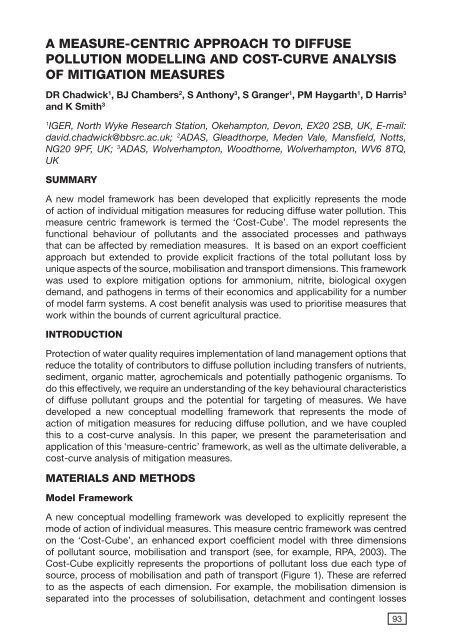Download as a PDF - CiteSeerX
Download as a PDF - CiteSeerX
Download as a PDF - CiteSeerX
You also want an ePaper? Increase the reach of your titles
YUMPU automatically turns print PDFs into web optimized ePapers that Google loves.
A MEASURE-CENTRIC APPROACH TO DIFFUSE<br />
POLLUTION MODELLING AND COST-CURVE ANALYSIS<br />
OF MITIGATION MEASURES<br />
DR Chadwick 1 , BJ Chambers 2 , S Anthony 3 , S Granger 1 , PM Haygarth 1 , D Harris 3<br />
and K Smith 3<br />
1<br />
IGER, North Wyke Research Station, Okehampton, Devon, EX20 2SB, UK, E-mail:<br />
david.chadwick@bbsrc.ac.uk; 2 ADAS, Gleadthorpe, Meden Vale, Mansfield, Notts,<br />
NG20 9PF, UK; 3 ADAS, Wolverhampton, Woodthorne, Wolverhampton, WV6 8TQ,<br />
UK<br />
SUMMARY<br />
A new model framework h<strong>as</strong> been developed that explicitly represents the mode<br />
of action of individual mitigation me<strong>as</strong>ures for reducing diffuse water pollution. This<br />
me<strong>as</strong>ure centric framework is termed the ‘Cost-Cube’. The model represents the<br />
functional behaviour of pollutants and the <strong>as</strong>sociated processes and pathways<br />
that can be affected by remediation me<strong>as</strong>ures. It is b<strong>as</strong>ed on an export coefficient<br />
approach but extended to provide explicit fractions of the total pollutant loss by<br />
unique <strong>as</strong>pects of the source, mobilisation and transport dimensions. This framework<br />
w<strong>as</strong> used to explore mitigation options for ammonium, nitrite, biological oxygen<br />
demand, and pathogens in terms of their economics and applicability for a number<br />
of model farm systems. A cost benefit analysis w<strong>as</strong> used to prioritise me<strong>as</strong>ures that<br />
work within the bounds of current agricultural practice.<br />
INTRODUCTION<br />
Protection of water quality requires implementation of land management options that<br />
reduce the totality of contributors to diffuse pollution including transfers of nutrients,<br />
sediment, organic matter, agrochemicals and potentially pathogenic organisms. To<br />
do this effectively, we require an understanding of the key behavioural characteristics<br />
of diffuse pollutant groups and the potential for targeting of me<strong>as</strong>ures. We have<br />
developed a new conceptual modelling framework that represents the mode of<br />
action of mitigation me<strong>as</strong>ures for reducing diffuse pollution, and we have coupled<br />
this to a cost-curve analysis. In this paper, we present the parameterisation and<br />
application of this ‘me<strong>as</strong>ure-centric’ framework, <strong>as</strong> well <strong>as</strong> the ultimate deliverable, a<br />
cost-curve analysis of mitigation me<strong>as</strong>ures.<br />
MATERIALS AND METHODS<br />
Model Framework<br />
A new conceptual modelling framework w<strong>as</strong> developed to explicitly represent the<br />
mode of action of individual me<strong>as</strong>ures. This me<strong>as</strong>ure centric framework w<strong>as</strong> centred<br />
on the ‘Cost-Cube’, an enhanced export coefficient model with three dimensions<br />
of pollutant source, mobilisation and transport (see, for example, RPA, 2003). The<br />
Cost-Cube explicitly represents the proportions of pollutant loss due each type of<br />
source, process of mobilisation and path of transport (Figure 1). These are referred<br />
to <strong>as</strong> the <strong>as</strong>pects of each dimension. For example, the mobilisation dimension is<br />
separated into the processes of solubilisation, detachment and contingent losses<br />
93

















